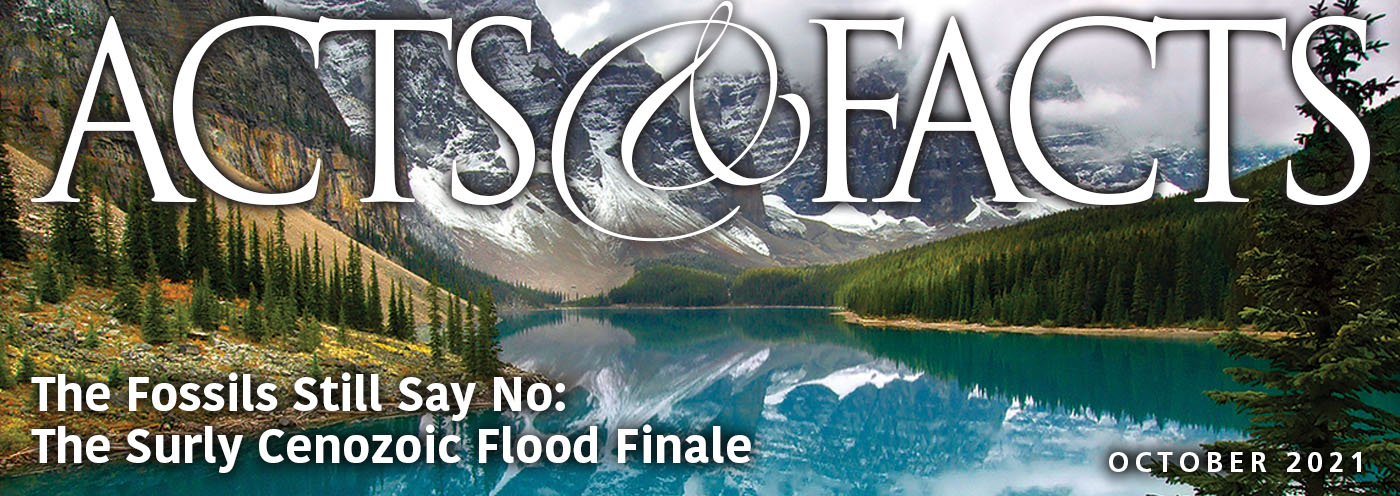Because of the amount of time it takes distant light to reach earth, the farther away an object is, the further back in time it appears to be. Thus, peering through a telescope is like peering into the past.1 If the naturalistic Big Bang cosmology is accurate, then objects so far away that they were made soon after the Big Bang should still look randomized, spread out, and "immature." But what astronomers have found is a fully mature galaxy in a very distant segment of outer space.
One of the last things Big Bang believers would have expected to see is an "old" galaxy with well-defined edges in a part of the universe that is so far from earth. It was so far, in fact, that it required gravitational lensing to even detect it.2 Gravitational lensing occurs when the space between a distant object and the earth is warped by a large mass, in this case that of the Abell 383 galactic cluster. Light travelling from the distant object follows the warped space, resulting in two identical images of that object. Also, its light is accelerated by the intervening mass, providing a much greater brightness for that object than would normally be seen from earth.
The new star was formed "just 200 million years after the big bang," according to Astronomy Now Online.3 Johan Richard, who described the galaxy in the Monthly Notices of the Royal Astronomical Society, commented, "This challenges theories of how soon galaxies formed and evolved in the first years of the universe."2 But instead of calling into question the timing of galaxy formation, this discovery should be taken as a general challenge to all theories of stellar evolution.
In a similar vein, Richard and his co-authors stated, "Taken at face value, the presence of a large optical break and an inferred mature stellar population (∼800 [million years]) only 1 [billion years] after the Big Bang is challenging."4
"Challenging" is an understatement. "Inexplicable" or "contradictory" would perhaps better suit this galaxy, since the authors did not offer any explanation for the "challenge" that this data poses to Big Bang cosmology. In the common conception of stellar evolution, 200 million years is not enough time for the Big Bang's randomly distributed gases to have coalesced into well-formed stars and galaxies.5
Why are "old" galaxies found in "young" space? Perhaps God put them there to confound "nature-only" attempts to explain the universe. Fully mature objects found in distant space make sense if galaxies were specially created by God.6
References
- A few cosmologies have been constructed that accommodate more data with fewer ad hoc assumptions than the Big Bang, showing that billions of non-earth years' worth of space-stretching could have occurred in just a few brief moments of earth time on Day 4 of the creation week. See, for example, all three parts of Dr. Larry Vardiman and Dr. Russell Humphreys' series "A New Creationist Cosmology: In No Time at All."
- First Galaxies Born Sooner After Big Bang Than Thought. Space.com. Posted on space.com April 14, 2011, accessed May 17, 2011.
- Baldwin, E. Stars born 200 million years after big bang. Astronomy Now Online. Posted on astronomynow.com April 13, 2011, accessed May 17, 2011.
- Richard, J. et al. Discovery of a possibly old galaxy at z = 6.027, multiply imaged by the massive cluster Abell 383. Monthly Notices of the Royal Astronomical Society. Published online before print April 13, 2011.
- Actually, the addition of time does not make star formation any more feasible. Since a nearby exploding star would be necessary to form a new star naturally, it stands to reason that the first stars…and therefore the galaxies that they inhabit…must have been intentionally created. See Thomas, B. Does a Distant Galaxy Show Star Formation? ICR News. Posted on icr.org March 29, 2010, accessed May 17, 2011.
- Similarly, a whole galactic cluster was recently found in more distant space. See Thomas, B. Distant Galactic Cluster Should Not Exist. ICR News. Posted on icr.org May 21, 2010, accessed May 17, 2011. And Thomas, B. Quasars Quash Big Bang Assumption. ICR News. Posted on icr.org April 29, 2010, accessed May 18, 2011.
Image Credit: NASA, ESA, J. Richard (CRAL), J.-P. Kneib (LAM). Acknowledgement: Marc Postman (STScI).
* Mr. Thomas is Science Writer at the Institute for Creation Research.
Article posted on May 24, 2011.







